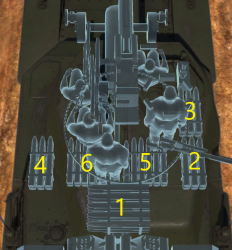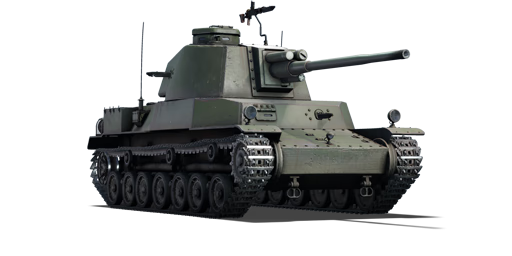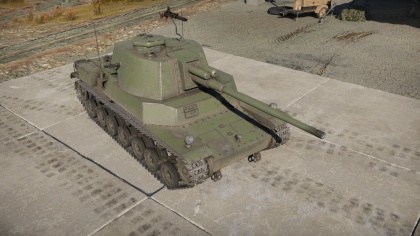Difference between revisions of "Chi-To"
(→Armaments) (Tag: Visual edit) |
Colok76286 (talk | contribs) (→Usage in battles: Corrected header) |
||
| Line 183: | Line 183: | ||
|} | |} | ||
| − | == Usage in | + | == Usage in battles == |
<!--''Describe the tactics of playing in the vehicle, the features of using vehicles in the team and advice on tactics. Refrain from creating a "guide" - do not impose a single point of view but give the reader food for thought. Describe the most dangerous enemies and give recommendations on fighting them. If necessary, note the specifics of the game in different modes (AB, RB, SB).''--> | <!--''Describe the tactics of playing in the vehicle, the features of using vehicles in the team and advice on tactics. Refrain from creating a "guide" - do not impose a single point of view but give the reader food for thought. Describe the most dangerous enemies and give recommendations on fighting them. If necessary, note the specifics of the game in different modes (AB, RB, SB).''--> | ||
As previously stated, the Chi-To best performs in the role of sniper, engaging hulldown at medium to long range against opposing medium tanks. The good gun depression, average mobility, and good reverse speed allow you to make it to good positions at an average pace and allow you to reverse back into cover when reloading. | As previously stated, the Chi-To best performs in the role of sniper, engaging hulldown at medium to long range against opposing medium tanks. The good gun depression, average mobility, and good reverse speed allow you to make it to good positions at an average pace and allow you to reverse back into cover when reloading. | ||
Revision as of 12:16, 1 September 2020
Contents
| This page is about the medium tank Chi-To. For the late version, see Chi-To Late |
Description
The Type 4 Chi-To is a Rank III Japanese medium tank
with a battle rating of 4.7 (AB/RB/SB). It was introduced along with the initial Japanese Ground Forces tree in Update 1.65 "Way of the Samurai".
The Type 4 Chi-To looks similar to the Type 3 Chi-Nu, though with a longer chassis with an extra wheel. Turret is also similar in look, though the turret side is more smooth and has a machine gun sticking out the right side. The big differences on the turret is the gun barrel. The gun barrel has no muzzle brake in its design and the recoil tube has been moved from a single tube on the bottom to two tubes on top.
Playing the Type 4 Chi-To can give the player a new impression of the Japanese tree line and a lasting one considering many of the Japanese tanks after it follow the same pattern. A tank with a very powerful cannon, decent mobility, but rather terrible armour. The terrible armour plus the tank's rather long reload means that the Chi-To is meant more for a long-distance shoot out than a close encounter.
General info
Survivability and armour
Armour type:
- Rolled homogeneous armour
- Cast homogeneous armour (Gun mantlet, Machine gun port)
| Armour | Front | Sides | Rear | Roof |
|---|---|---|---|---|
| Hull | 75 mm (17°) Front plate 20 mm (76°) Front glacis 75 mm (16°), 20 mm (58°) Lower glacis 50 mm (12°) Front cheeks 50 mm (0-66°) Machine gun port |
35 mm (12-30°) Top 35 mm Bottom |
20 mm (73°) Top 35 mm Center 20 mm (48°) Bottom |
20 mm |
| Turret | 75 mm (16°) Turret front 50-75 mm (10°) Gun mantlet |
50 mm (15-16°) 50 mm (0-65°) Right machine gun port |
50 mm (15-50°) Turret rear 10 mm Turret rear underside |
20 mm |
| Armour | Sides | Roof | ||
| Cupola | 75 mm | 20 mm |
Notes:
- Suspension wheels are 15 mm thick while tracks are 20 mm thick.
- 10 mm RHA plates are scattered on the lower side hull.
- Turret ring is 20 mm thick.
Mobility
| Game Mode | Max Speed (km/h) | Weight (tons) | Engine power (horsepower) | Power-to-weight ratio (hp/ton) | |||
|---|---|---|---|---|---|---|---|
| Forward | Reverse | Stock | Upgraded | Stock | Upgraded | ||
| Arcade | 50 | 10 | 30.5 | 620 | 954 | 20.33 | 31.28 |
| Realistic | 45 | 9 | 354 | 500 | 11.61 | 16.39 | |
Armaments
Main armament
| 75 mm Type II Model II | |||||
|---|---|---|---|---|---|
| Capacity | Vertical guidance |
Horizontal guidance |
Stabilizer | ||
| 55 | -10°/+20° | ±180° | N/A | ||
| Turret rotation speed (°/s) | |||||
| Mode | Stock | Upgraded | Prior + Full crew | Prior + Expert qualif. | Prior + Ace qualif. |
| Arcade | 12.09 | 16.73 | 20.32 | 22.47 | 23.91 |
| Realistic | 7.56 | 8.89 | 10.76 | 11.94 | 12.7 |
| Reloading rate (seconds) | |||||
| Stock | Prior + Full crew | Prior + Expert qualif. | Prior + Ace qualif. | ||
| 10.01 | 8.86 | 8.16 | 7.7 | ||
Ammunition
| Penetration statistics | |||||||
|---|---|---|---|---|---|---|---|
| Ammunition | Type of warhead |
Penetration in mm @ 90° | |||||
| 10m | 100m | 500m | 1000m | 1500m | 2000m | ||
| Type 1 APHE | APHE | 137 | 133 | 120 | 102 | 89 | 78 |
| Type 4 Kou | APHE | 157 | 155 | 142 | 124 | 111 | 105 |
| Type 90 HE | HE | 8 | 8 | 8 | 8 | 8 | 8 |
| Shell details | ||||||||||
|---|---|---|---|---|---|---|---|---|---|---|
| Ammunition | Type of warhead |
Velocity in m/s |
Projectile Mass in kg |
Fuse delay
in m: |
Fuse sensitivity
in mm: |
Explosive Mass in g (TNT equivalent): |
Normalization At 30° from horizontal: |
Ricochet: | ||
| 0% | 50% | 100% | ||||||||
| Type 1 APHE | APHE | 865 | 6.6 | 1.3 | 15 | 67.84 | ° | 47° | 60° | 65° |
| Type 4 Kou | APHE | 865 | 6.8 | 1.3 | 15 | 80.64 | ° | 47° | 60° | 65° |
| Type 90 HE | HE | 830 | 6.2 | 0.1 | 0.1 | 490 | +0° | 79° | 80° | 18° |
Ammo racks

| Full ammo |
1st rack empty |
2nd rack empty |
3rd rack empty |
4th rack empty |
5th rack empty |
6th rack empty |
7th rack empty |
Recommendations | Visual discrepancy |
|---|---|---|---|---|---|---|---|---|---|
| 55 | 45 (+10) | 40 (+15) | 34 (+21) | 28 (+27) | 28 (+27) | 14 (+41) | 1 (+54) | No |
Turret empty: 40 (+15)
Machine guns
| 7.7 mm Type 97 | ||||||
|---|---|---|---|---|---|---|
| Pintle mount | ||||||
| Capacity (Belt capacity) | Fire rate (shots/minute) |
Vertical guidance |
Horizontal guidance | |||
| 1,000 (20) | 499 | -10°/+70° | ±60° | |||
| Hull mount | ||||||
| Capacity (Belt capacity) | Fire rate (shots/minute) |
Vertical guidance |
Horizontal guidance | |||
| 3,000 (20) | 499 | ±8° | ±8° | |||
Usage in battles
As previously stated, the Chi-To best performs in the role of sniper, engaging hulldown at medium to long range against opposing medium tanks. The good gun depression, average mobility, and good reverse speed allow you to make it to good positions at an average pace and allow you to reverse back into cover when reloading.
Against most heavies such as the IS-1/2, Tiger, or Panther, it is only worthwhile to engage if you are already entrenched in a solid defensive position. Your gun's lack of APCBC gives you poor performance against slopes and rounded armour on the IS, Panther, and angled Tigers, making any ranged engagement near useless. Against tanks such as the Jumbo 75 or 76, it is best to disengage and flank them or have teammates flank them. Against all other medium tanks, shots to the hull will suffice at most range.
The M4A3E2 Jumbo could be a menace if not handled properly as they are nigh impenetrable from the front due to its thick armour. Either try for a very precise shot through the MG port in the front or shoot the armour behind the tracks if they are angled. The best way to deal with a Sherman Jumbo is to shoot it through the side or between the side plate and the tracks. There is a small gap between the top of the tracks and the bottom of the side plate that can be easily penetrated by the Chi-To Late, and a successful penetration here usually results in a one-shot, or a destroyed/alight engine. This weak spot is relatively easy to exploit as most Jumbo drivers make the mistake of angling their armour, which gives you full view of this weak spot. If you are struggling to hit it, then a shot through the drive wheel at an angle of 45º or more usually works quite well also. You should feel no pressure to get this right the first time, as a well-angled Chi-To Late can reliably bounce the Jumbo's shells, unless the Jumbo in question happens to be sporting the 76mm M1A1 cannon.
The IS series of tanks can also be a bit of a bother to deal with. At this battle rating, you may find the IS-1, IS-2 or IS-2 mod. 1944 (rare). However, they can be defeated by exploiting the shot trap on the turret front (requires some luck), shooting the driver's hatch on the front or the gun mantlet (requires extreme precision and luck), shooting the lower frontal plate (the most reliable way to kill an IS) or shooting the frontal armour plate from a 90º angle. That being said, your tank can still one-shot the IS series you'll face by shooting directly beneath the turret ring.
You may encounter the German "Big Cat" tanks (Tiger H1, Tiger E, Panther D, Panther A) if you get seriously up tiered. In this case the best thing you can do is hit them from the side, which usually results in a one-shot. If facing a Tiger (or any German Big Cat for that matter) from the front, you should retreat. However, if his frontal plate is not angled, then it might be worth a shot to shoot between the machine gun port and driver's hatch, which will result in a one-shot. As for the panther, try to exploit the shot trap on the turret, but only as a last resort. Your first port of call should be to shoot the drive wheel, basically following the same tactics you'd use for dealing with a Sherman Jumbo.
As for some other enemies:
A42 Churchill VII: do not engage from the front at all. Sneak around to the side and shoot there. ARL 44: shoot the sides. It's not worth facing this tank head on, it's too much of a risk. ARL 44 ACL-1: aim for the turret if you face this tank from the front, then finish it from the sides. Be careful not to get shot. M6 Heavy: the frontal armour on this thing can be a bit fiddly. Aim for a spot that doesn't seem to have more than one armour plate layered on it.
Most tanks you face can penetrate you frontally if they shoot your frontal plate when it is not angled. It is recommended to get the first shot off and then retreat, and make a second surprise attack. Most of the time, a penetration results in a one-shot with this tank. You can penetrate pretty much any medium or light tank frontally by shooting the upper front plate, so use that to your advantage.
Modules
| Tier | Mobility | Protection | Firepower | ||
|---|---|---|---|---|---|
| I | Tracks | Parts | Horizontal Drive | ||
| II | Suspension | Brake System | FPE | Adjustment of Fire | Type 4 Kou |
| III | Filters | Crew Replenishment | Elevation Mechanism | ||
| IV | Transmission | Engine | Artillery Support | ||
Pros and cons
Pros:
- Powerful 75 mm cannon rivaling the T-34-85's, good penetration and very low shell drop-off.
- APHE round can easily defeat enemy tanks.
- A very powerful tank at 4.3, can tackle all foes at its BR bracket.
- Decent gun depression of -11°
- Ammo in the turret can be emptied by carrying 15 less ammo.
- Very powerful Type 4 Kou shell with more penetration and more explosive filler.
- Decent top armour, enough to resist strafing aircraft weapons.
Cons:
- Armour is average and mostly flat and unangled, like the Panzer IV.
- The Chi-To is asymmetric and is a large tank, it is difficult to hide from enemies.
- Reload rate quite slow.
- Angling front armour can expose the 50 mm hull cheek armour.
- Very hard to turn on the spot, especially when stock.
History
Development
The lackluster performance of Japanese tanks in World War II called for the development of newer medium tanks in the Imperial Japanese Army. The standard tank of the time was the Type 97 Chi-Ha, which has its chassis used in many expedient models to provide a bigger gun for the Japanese inventory such as the Chi-Ha Kai, Type 1 Chi-He, Type 2 Ho-I, and Type 3 Chi-Nu. By the time of Chi-Nu, however, the Chi-Ha chassis was becoming outdated and so a new tank design using an improved chassis was needed for future development.[1]
In 1943, development started of the Chi-To tank, which features a new chassis and more powerful engine. Its armament is a 75 mm gun based off the Type 88 anti-aircraft gun, giving it a high-velocity weapon. Armour on the tank was welded and was quite thick in comparison to its predecessor at 75 mm thick. The tank was accepted for service in 1944 and was expected to enter mass production with 20 per month at Mitsubishi and 5 per month at Kobe-Seiko. In terms of Japanese armour development, the Chi-To was the most sophisticated tank to enter production levels.[1]
War's End
Despite its potential, the Type 4 Chi-To was never made in large numbers. At the war's end, only six chassis were made, with only two of those made into tanks.
The two Type 4 produced were cast into Lake Hamana between the 23 and the 28 August 1945 to avoid their capture. One was found by the U.S. occupation forces following Japan's surrender in World War II. The tank was then transported to Aberdeen Proving Grounds for tests and would eventually scrap them in October 1952.[2]
The second tank is still believed to be at the bottom of the lake. A project to find it was launched in 2013 by SM@Pe, a group of people from Hamamatsu. Inhabitants, volunteers, divers and the Windy Network Corp ( a marine studies company from Tôkyô who founded a trainning plane of the Japanese imperial army in the lake Towada in 2010) participated to research, supported by the use of a sonar and testimonials, including former soldiers who allegedly participated in the launching operation. The research did not give anything.
Media
An excellent addition to the article will be video guides, as well as screenshots from the game and photos.
References
Read also
Links to the articles on the War Thunder Wiki that you think will be useful for the reader, for example,
- reference to the series of the vehicles;
- links to approximate analogues of other nations and research trees.
ETC.
Sources
- Zaloga Steven. Japanese Tanks 1939-1945 Great Britain: Osprey Publishing Ltd., 2007
- Sun, Eun Ae. Chi-Ri & Chi-To: Aberdeen Tank Scrapping. YouTube, YouTube, 7 Aug. 2017, Video
| Japan medium tanks | |
|---|---|
| Type 97 | Chi-Ha · Chi-Ha Kai · Chi-Ha Kai TD · Chi-Ha Short Gun |
| Type 1 | Chi-He · Chi-He (5th Regiment) · Ho-I |
| Type 3 | Chi-Nu · Chi-Nu II |
| Type 4 | Chi-To · Chi-To Late |
| Type 5 | Chi-Ri II |
| Type 61 MBT | ST-A1* · ST-A2* · ST-A3* · Type 61 |
| Type 74 MBT | ST-B2* · Type 74 (C) · Type 74 (E) · Type 74 (F) · Type 74 (G) |
| Type 90 MBT | Type 90 · Type 90 (B) · Type 90B "Fuji" |
| Type 10 MBT | TKX (P)* · TKX* · Type 10 |
| Other | Ka-Chi |
| USA | ▅M4A3 (76) W · ▅M47 |
| *Prototype | |





